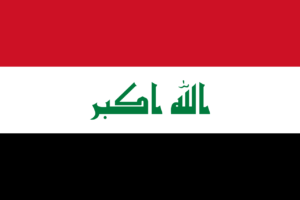Information about Iraq:
| Capital | Baghdad |
| Population | 45,692,330 (Source: 2023 worldometer) |
| Major Cities | Baghdad (capital), Erbil, Mosul, Basra, Najaf, Karbala, Hillah, Samarra, Nasiriyah |
| Borders | Kuwait, Iran, Turkey, Syria, Jordan, and Saudi Arabia |
| Gross Domestic Product (GDP) | $264,182,000,000 (2022 worldometer) |
| Currency | New Iraqi dinar (NID) as of 22 January 2004 |
Flag of Iraq:
Flag description: On January 22, 2008, the Iraqi flag was adopted. It has three red, white, and black horizontal stripes at the top, middle, and bottom, respectively. The Arab Liberation Flag’s colors are these. The Iraqi national anthem, “Allahu Akbar,” which is written in green in the center of the flag, is translated as “God is Great.”
Iraq Economy Key Industries:
Iraq Major Industries: petroleum, chemicals, textiles, leather, construction materials, food processing, fertilizer, metal fabrication/processing
Iraq Agricultural Products: wheat, barley, rice, vegetables, dates, cotton; cattle, sheep, poultry
Iraq Natural Resources: petroleum, natural gas, phosphates, sulfur
Iraq Major Exports: crude oil (83.9%), crude materials excluding fuels (8.0%), food and live animals (5.0%)
Iraq Major Imports: food, medicine, manufactures
The Geography of Iraq:
Total Size of Iraq: 438,317 km2 (source: wikipedia)
Geographical Low Point of Iraq: Persian Gulf 0 m
Geographical High Point of Iraq: unnamed peak; 3,611 m; note – this peak is not Gundah Zhur 3,607 m or Kuh-e Hajji-Ebrahim 3,595 m
Climate of Iraq: mostly desert; mild to cool winters with dry, hot, cloudless summers; northern mountainous regions along Iranian and Turkish borders experience cold winters with occasionally heavy snows that melt in early spring, sometimes causing extensive flooding in central and southern Iraq
General Terrain of Iraq: mostly broad plains; reedy marshes along Iranian border in south with large flooded areas; mountains along borders with Iran and Turkey
World Region or Continent of Iraq: Middle East
Geographical Coordinates: 33 00 N, 44 00 E
Major Landforms of Iraq: Syrian Desert, Arabian Desert, Zagros Mountains, Upper Mesopotamia, Lower Mesopotamia, Cheeka Dar
Major Bodies of Water: Tigris River, Euphrates River, Shatt as-Arab, Diyala River, Great Zab River, Lake Tharthar, Lake Habbaniyah, Persian Gulf
Famous Places of Iraq:
Babylon ruins,
Ziggurat of Ur,
Persepolis,
Imam Ali Mosque,
Hatra Ruins,
National Museum of Iraq,
Great Mosque of Samarra,
Eram Garden,
Tomb of Hafez,
Al-Shaheed Monument,
Abbasid Palace,
Basra canals,
Nineveh
The People of Iraq & Culture
Iraq Government Type: transitional democracy
Iraq Nationality: Iraqi(s)
Iraq National Holiday: Revolution Day, 17 July (1968); note – this holiday was celebrated under the Saddam Hussein regime but the Iraqi Interim Government has yet to declare a new national holiday
Other Holidays of Iraq: New Years’ Day (January 1), Armed Forces Day (January 6), Liberation Day (April 9), Republic Day (July 14), Independence Day (October 3), Islamic New Year, Ashura, Ramadan, Prophet’s Birthday
Iraq Independence: 3 October 1932 (from League of Nations mandate under British administration); note – on 28 June 2004 the Coalition Provisional Authority transferred sovereignty to the Iraqi Interim Government
Iraq National Symbol:
- Animal – Eagle
- Bird – Chukar Partridge
- Flower – Rose
- Tree – Date palm
- Motto – God is the Greatest
- Coat of arms – Eagle of Saladin with a shield that has the colors of the flag
- Colors – Red, white, green, black
Iraq National Anthem or Song: Mawtini (My Homeland)
Iraq Languages Spoken: Arabic, Kurdish (official in Kurdish regions), Assyrian, Armenian
Iraq Religions: Muslim 97% (Shi’a 60%-65%, Sunni 32%-37%), Christian or other 3%
Interesting Facts about Iraq:
Iraq is home to the oldest civilization on Earth.
The world’s earliest writing was first discovered in Iraq.
Iraq attained independence in 1932.
The words “Allahu akbar” (God is glorious) are printed in green over three horizontal red, white, and black stripes that make up the Iraqi flag. Red, green, black, and white stand for the willingness to shed blood, the country’s fields, the nation’s conflicts, and the sincerity of one’s intents and deeds.
The Persian terms “bagh” and “dad,” which mean “god” and “gift” respectively, are most likely the names of Baghdad, the capital and largest city of Iraq. “Given by God” is a translation of this.
Iraq is one of the world’s top oil producers. As of 2018, its 148 billion barrels of oil reserves put it sixth in the globe.
The 2020 Global Gender Gap Index ranked Iraq as the second-worst country in the world for gender equality.
The Silk Road, a historic trade route linking China with Europe and the Middle East, stopped at Iraq. Baghdad served as an important economic hub and crossroads on the Silk Road network because of its ideal geographic location.
Iraq is a country in the Middle East and is known as the Republic of Iraq in official documents.
Baghdad, the nation’s capital, is situated in the east of the country.
In Iraq, over half of all married couples are first or second cousins.
In 1979, Iraq forbade karate movies.
Both Kleicha, the national cookie of Iraq, and Masgouf, the country’s national dish of impaled fish, have long histories.
Soccer is the most popular sport in Iraq. Other activities that Iraqis like include basketball, boxing, weightlifting, horseback riding, and horse races.
In Iraq, beekeeping dates back 5,000 years. Honey is a vital food and money source for many Iraqi families.
The official money of Iraq is the dinar, which is derived from the Latin word deni, which meaning “ten.”
Iraq, which is in the Middle East, borders Iran, Turkey, Syria, Jordan, and Saudi Arabia on land.


